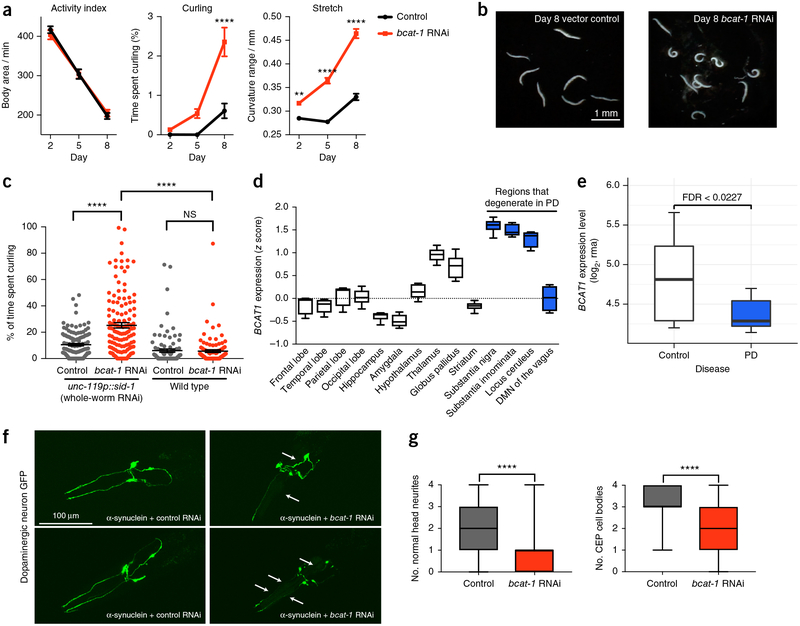Figure 5.
Adult-onset bcat-1-knockdown in neurons causes age-specific motor defects. (a) bcat-1 and control RNAi-treated unc-119p::sid-1 worms (which are sensitive to RNAi in all tissues) exhibit decreased overall activity with age, whereas curling and stretch phenotypes markedly increase with age in worms with bcat-1 knockdown. Videos were analyzed with CeleST28. Mean ± s.e.m., two-way analysis of variance (ANOVA) with Sidak’s multiple-comparison test, n ≥ 345 worms per day and condition, *P < 0.05, **P < 0.01, ***P < 0.001, ****P < 0.0001. (b) Curling posture on day 8, shown in bcat-1-knockdown worms compared with control. The experiment was repeated three times independently and yielded similar results. (c) Curling of day 8 unc-119p::sid-1 (TU3311) and N2 (wild-type) animals. Mean ± s.e.m., two-way repeated-measures ANOVA with Sidak’s multiple-comparison test, n ≥ 98 worms per group, NS, not significant, *P < 0.05, **P < 0.01, ***P < 0.001, ****P < 0.0001. Worm thrashing videos were counted by hand. (d) Average BCAT1 expression in selected brain regions in healthy human subjects from the Allen Brain Atlas (mean ± s.e.m. shown). Average age = 42.5 years. n = 6 human donors for each sample from the Allen Brain Atlas database for gene expression. DMN, dorsal motor nucleus. (e) log2 expression (robust-multiarray-average normalized) of BCAT1 in the substantia nigra in controls (n = 13 individuals) and patients with PD (n = 24)26. (f) bcat-1 RNAi exacerbates the toxic effect of α-synuclein in dopaminergic neurons, as measured on day 6 of adulthood. Arrows show loss of neurites and abnormal projections in RNAi-sensitive worms expressing α-synuclein in dopaminergic neurons exposed to bcat-1 or control RNAi. The experiment was repeated three times independently and yielded similar results. (g) Quantification of neurite damage in head dopaminergic neurons and cephalic sensilla (CEP) cell-body loss. Mean ± s.e.m., two-sided unpaired t-test, L4440, n = 45 worms; bcat-1 RNAi, n = 61 worms. Top, ****P = 3.46 × 10−7; bottom, ****P = 2.19 × 10−6. The experiment was repeated three times independently and yielded similar results. Box plots show minimum, first quartile, median, third quartile, and maximum values. More details are provided in Online Methods, ‘Statistics and reproducibility’.

